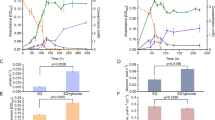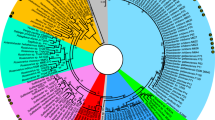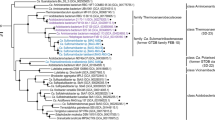Abstract
Roseobacter clade bacteria (RCB) are abundant in marine bacterioplankton worldwide and central to pelagic sulfur cycling. Very little is known about their abundance and function in marine sediments. We investigated the abundance, diversity and sulfur oxidation potential of RCB in surface sediments of two tidal flats. Here, RCB accounted for up to 9.6% of all cells and exceeded abundances commonly known for pelagic RCB by 1000-fold as revealed by fluorescence in situ hybridization (FISH). Phylogenetic analysis of 16S rRNA and sulfate thiohydrolase (SoxB) genes indicated diverse, possibly sulfur-oxidizing RCB related to sequences known from bacterioplankton and marine biofilms. To investigate the sulfur oxidation potential of RCB in sediments in more detail, we analyzed a metagenomic fragment from a RCB. This fragment encoded the reverse dissimilatory sulfite reductase (rDSR) pathway, which was not yet found in RCB, a novel type of sulfite dehydrogenase (SoeABC) and the Sox multi-enzyme complex including the SoxCD subunits. This was unexpected as soxCD and dsr genes were presumed to be mutually exclusive in sulfur-oxidizing prokaryotes. This unique gene arrangement would allow a metabolic flexibility beyond known sulfur-oxidizing pathways. We confirmed the presence of dsrA by geneFISH in closely related RCB from an enrichment culture. Our results show that RCB are an integral part of the microbial community in marine sediments, where they possibly oxidize inorganic and organic sulfur compounds in oxic and suboxic sediment layers.
Similar content being viewed by others
Log in or create a free account to read this content
Gain free access to this article, as well as selected content from this journal and more on nature.com
or
References
Alderkamp AC, Sintes E, Herndl GJ . (2006). Abundance and activity of major groups of prokaryotic plankton in the coastal North Sea during spring and summer. AME 45: 237–246.
Alonso C, Pernthaler J . (2005). Incorporation of glucose under anoxic conditions by bacterioplankton from coastal North Sea surface waters. Appl Environ Microbiol 71: 1709–1716.
Brinkhoff T, Giebel HA, Simon M . (2008). Diversity, ecology, and genomics of the Roseobacter clade: a short overview. Arch Microbiol 189: 531–539.
Brune DC . (1989). Sulfur oxidation by phototrophic bacteria. Biochim Biophys Acta 975: 189–221.
Buchan A, Gonzalez JM, Moran MA . (2005). Overview of the marine Roseobacter lineage. Appl Environ Microbiol 71: 5665–5677.
Curson ARJ, Todd JD, Sullivan MJ, Johnston AWB . (2011). Catabolism of dimethylsulphoniopropionate: microorganisms, enzymes and genes. Nat Rev Micro 9: 849–859.
Dang HY, Lovell CR . (2002). Numerical dominance and phylotype diversity of marine Rhodobacter species during early colonization of submerged surfaces in coastal marine waters as determined by 16S ribosomal DNA sequence analysis and fluorescence in situ hybridization. Appl Environ Microbiol 68: 496–504.
Eichhorn E, van der Ploeg JR, Kertesz MA, Leisinger T . (1997). Characterization of alpha-ketoglutarate-dependent taurine dioxygenase from Escherichia coli. J Biol Chem 272: 23031–23036.
Eilers H, Pernthaler J, Glöckner FO, Amann R . (2000). Culturability and in situ abundance of pelagic bacteria from the North Sea. Appl Environ Microbiol 66: 3044–3051.
Eilers H, Pernthaler J, Peplies J, Glockner FO, Gerdts G, Amann R . (2001). Isolation of novel pelagic bacteria from the German bight and their seasonal contributions to surface picoplankton. Appl Environ Microbiol 67: 5134–5142.
Fazi S, Amalfitano S, Pernthaler J, Puddu A . (2005). Bacterial communities associated with benthic organic matter in headwater stream microhabitats. Environ Microbiol 7: 1633–1640.
Franz B, Gehrke T, Lichtenberg H, Hormes J, Dahl C, Prange A . (2009). Unexpected extracellular and intracellular sulfur species during growth of Allochromatium vinosum with reduced sulfur compounds. Microbiol Sgm 155: 2766–2774.
Friedrich CG, Rother D, Bardischewsky F, Quentmeier A, Fischer J . (2001). Oxidation of reduced inorganic sulfur compounds by bacteria: Emergence of a common mechanism? Appl Environ Microbiol 67: 2873–2882.
Frigaard NU, Dahl C . (2009). Sulfur metabolism in phototrophic sulfur bacteria. Adv Microb Physiol 54: 103–200.
Glöckner FO, Fuchs BM, Amann R . (1999). Bacterioplankton compositions of lakes and oceans: a first comparison based on fluorescence in situ hybridization. Appl Environ Microbiol 65: 3721–3726.
Gonzalez JM, Kiene RP, Moran MA . (1999). Transformation of sulfur compounds by an abundant lineage of marine bacteria in the alpha-subclass of the class Proteobacteria. Appl Environ Microbiol 65: 3810–3819.
Gonzalez JM, Moran MA . (1997). Numerical dominance of a group of marine bacteria in the alpha-subclass of the class Proteobacteria in coastal seawater. Appl Environ Microbiol 63: 4237–4242.
Gregersen LH, Bryant DA, Frigaard N-U . (2011). Mechanisms and evolution of oxidative sulfur metabolism in green sulfur bacteria. Front Microbiol 2 116: 1–14.
Grimm F, Franz B, Dahl C . (2008). Thiosulfate and sulfur oxidation in purple sulfur bacteria. In: Dahl C, Friedrich CG (eds). Microbial Sulfur Metabolism. Springer: Berlin, pp 101–116.
Hensen D, Sperling D, Truper HG, Brune DC, Dahl C . (2006). Thiosulphate oxidation in the phototrophic sulphur bacterium Allochromatium vinosum. Mol Microbiol 62: 794–810.
Howard EC, Henriksen JR, Buchan A, Reisch CR, Buergmann H, Welsh R et al (2006). Bacterial taxa that limit sulfur flux from the ocean. Science 314: 649–652.
Ishii K, Mussmann M, MacGregor BJ, Amann R . (2004). An improved fluorescence in situ hybridization protocol for the identification of bacteria and archaea in marine sediments. FEMS Microbiol Ecol 50: 203–212.
Jansen S, Walpersdorf E, Werner U, Billerbeck M, Bottcher ME, de Beer D . (2009). Functioning of intertidal flats inferred from temporal and spatial dynamics of O2, H2S and pH in their surface sediment. Ocean Dynam 59: 317–332.
Jørgensen BB . (1990). A thiosulfate shunt in the sulfur cycle of marine sediments. Science 249: 152–154.
Kamyshny A, Ferdelman TG . (2010). Dynamics of zero-valent sulfur species including polysulfides at seep sites on intertidal sand flats (Wadden Sea, North Sea). Mar Chem 121: 17–26.
Lavik G, Stuhrmann T, Bruchert V, Van der Plas A, Mohrholz V, Lam P et al (2009). Detoxification of sulphidic African shelf waters by blooming chemolithotrophs. Nature 457: 581–U586.
Lehmann S, Johnston AWB, Curson ARJ, Todd JD, Cook AM . (2012). SoeABC, a novel sulfite dehydrogenase in Roseobacters? In: Muyzer G, Stams AJM (eds) EMBO Workshop on Microbial Sulfur Metabolism 15–18 April 2012 (Abstract Book) Sieca Repro, Delft, p 29.
Lenk S, Arnds J, Zerjatke K, Musat N, Amann R, Mussmann M . (2011). Novel groups of Gammaproteobacteria catalyse sulfur oxidation and carbon fixation in a coastal, intertidal sediment. Environ Microbiol 13: 758–774.
Loy A, Duller S, Baranyi C, Mussmann M, Ott J, Sharon I et al (2009). Reverse dissimilatory sulfite reductase as phylogenetic marker for a subgroup of sulfur-oxidizing prokaryotes. Environ Microbiol 11: 289–299.
Meyer B, Imhoff JF, Kuever J . (2007). Molecular analysis of the distribution and phylogeny of the soxB gene among sulfur-oxidizing bacteria—evolution of the Sox sulfur oxidation enzyme system. Environ Microbiol 9: 2957–2977.
Moran MA, Belas R, Schell MA, Gonzalez JM, Sun F, Sun S et al (2007). Ecological genomics of marine roseobacters. Appl Environ Microbiol 73: 4559–4569.
Moran MA, Buchan A, Gonzalez JM, Heidelberg JF, Whitman WB, Kiene RP et al (2004). Genome sequence of Silicibacter pomeroyi reveals adaptations to the marine environment. Nature 432: 910–913.
Moraru C, Lam P, Fuchs BM, Kuypers MMM, Amann R . (2010). GeneFISH—an in situ technique for linking gene presence and cell identity in environmental microorganisms. Environ Microbiol 12: 3057–3073.
Moraru C, Moraru G, Fuchs BM, Amann R . (2011). Concepts and software for a rational design of polynucleotide probes. Environ Microbiol Rep 3: 69–78.
Mussmann M, Richter M, Lombardot T, Meyerdierks A, Kuever J, Kube M et al (2005). Clustered genes related to sulfate respiration in uncultured prokaryotes support the theory of their concomitant horizontal transfer. J Bacteriol 187: 7126–7137.
Newton RJ, Griffin LE, Bowles KM, Meile C, Gifford S, Givens CE et al (2010). Genome characteristics of a generalist marine bacterial lineage. ISME J 4: 784–798.
Petri R, Podgorsek L, Imhoff JF . (2001). Phylogeny and distribution of the soxB gene among thiosulfate-oxidizing bacteria. FEMS Microbiol Lett 197: 171–178.
Rinta-Kanto JM, Burgmann H, Gifford SM, Sun SL, Sharma S, del Valle DA et al (2011). Analysis of sulfur-related transcription by Roseobacter communities using a taxon-specific functional gene microarray. Environ Microbiol 13: 453–467.
Rother D, Henrich HJ, Quentmeier A, Bardischewsky F, Friedrich CG . (2001). Novel genes of the sox gene cluster, mutagenesis of the flavoprotein SoxF, and evidence for a general sulfur-oxidizing system in Paracoccus pantotrophus GB17. J Bacteriol 183: 4499–4508.
Sass H, Kopke B, Rutters H, Feuerlein T, Droge S, Cypionka H et al (2010). Tateyamaria pelophila sp nov., a facultatively anaerobic alphaproteobacterium isolated from tidal-flat sediment, and emended descriptions of the genus Tateyamaria and of Tateyamaria omphalii. Int J Syst Evol Microbiol 60: 1770–1777.
Sekar R, Fuchs BM, Amann R, Pernthaler J . (2004). Flow sorting of marine bacterioplankton after fluorescence in situ hybridization. Appl Environ Microbiol 70: 6210–6219.
Sievert SM, Hugler M, Taylor CD, Wirsen CO . (2008). Sulfur oxidation at deep-sea hydrothermal vents. In: Dahl C, Friedrich CG (eds). Microbial Sulfur Metabolism. Springer: Berlin, pp 238–258.
Sorokin DY . (1995). Sulfitobacter pontiacus, gen-nov, sp. nov.—a new heterotrophic bacterium from the Black Sea, specialized on sulfite oxidation. Microbiology 64: 295–305.
Sorokin DY . (2003). Oxidation of inorganic sulfur compounds by obligately organotrophic bacteria. Microbiology 72: 641–653.
Van den Ende FP, Van Gemerden H . (1993). Sulfide oxidation under oxygen limitation by a Thiobacillus thioparus isolated from a marine microbial mat. FEMS Microbiol Ecol 13: 69–77.
Wagner-Döbler I, Biebl H . (2006). Environmental biology of the marine Roseobacter lineage. Annu Rev Microbiol 60: 255–280.
Weber M, Teeling H, Huang SX, Waldmann J, Kassabgy M, Fuchs BM et al (2011). Practical application of self-organizing maps to interrelate biodiversity and functional data in NGS-based metagenomics. ISME J 5: 918–928.
Widdel F, Bak F . (1992). Gram-negative mesophilic sulfate-reducing bacteria. In: Balows A, Trüper HG, Dworkin M, Harder W, Schleifer K-H (eds). The Prokaryotes Vol. 1 2nd edn. Springer: New York, pp 3352–3378.
Acknowledgements
We thank A Krupke, C Probian, J Wulf, S Dyksma, K Bischof and K Zerjatke for excellent technical assistance. We are grateful to thank Felix Jansen, Manuel Kleiner, Juliane Wippler, Petra Pjevac and the MarMic students of class 2014 for providing sediment samples. We acknowledge the captains of ‘Spes Mea’ and ‘Doris von Ochtum’ for supporting the sampling campaigns. This work was funded by the German Science Foundation (DFG) during research group ‘Biogeochemistry of Tidal Flats’ (JO 307/4, BO 1584/4) and the Max Planck Society.
Author information
Authors and Affiliations
Corresponding author
Additional information
Supplementary Information accompanies the paper on The ISME Journal website
Supplementary information
Rights and permissions
About this article
Cite this article
Lenk, S., Moraru, C., Hahnke, S. et al. Roseobacter clade bacteria are abundant in coastal sediments and encode a novel combination of sulfur oxidation genes. ISME J 6, 2178–2187 (2012). https://doi.org/10.1038/ismej.2012.66
Received:
Revised:
Accepted:
Published:
Issue date:
DOI: https://doi.org/10.1038/ismej.2012.66
Keywords
This article is cited by
-
The impact of alloying element Cu on corrosion and biofilms of 316L stainless steel exposed to seawater
Environmental Science and Pollution Research (2024)
-
Insights into methionine S-methylation in diverse organisms
Nature Communications (2022)
-
Sulfur bacteria promote dissolution of authigenic carbonates at marine methane seeps
The ISME Journal (2021)
-
Bacterial community variations in the South China Sea driven by different chemical conditions
Ecotoxicology (2021)
-
Marine bacterial community analysis on 316L stainless steel coupons by Illumina MiSeq sequencing
Biotechnology Letters (2020)



